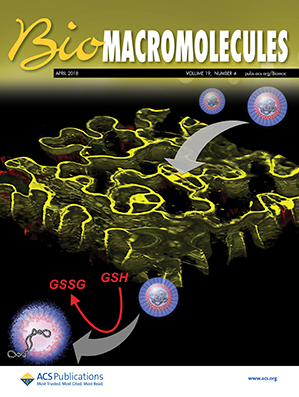分子量对聚(l-乳酸)海洋生物降解性的影响。
IF 5.4
2区 化学
Q1 BIOCHEMISTRY & MOLECULAR BIOLOGY
引用次数: 0
摘要
聚乳酸(PLA)是一种可生物降解的生物塑料,其海洋降解能力有限。本研究探讨了分子量对聚乳酸海洋生物降解性的影响。我们合成了聚合度(DP)介于 14 和 642 之间、带有末端羟基(PLA-OH)的聚乳酸,并进行了生化需氧量(BOD)测试。聚合度为 422 或 642 的样品与商用聚乳酸一样不会降解。然而,DP 低于 314 的聚乳酸-OH 具有生物降解性,DP 为 14 的降解性比纤维素高。尺寸排阻色谱法(SEC)证实,DP 值低于 314 的样品的分子量有所下降,这表明存在细胞外微生物活动。这些发现表明,与高分子量聚乳酸不同,DP 低于 314 的聚乳酸-OH 可在海洋条件下降解。如果能通过某种特定方法将高分子量聚乳酸的 DP 值降至 314,那么聚乳酸有望用于制造海洋生物可降解材料。本文章由计算机程序翻译,如有差异,请以英文原文为准。


Effects of Molecular Weight on the Marine Biodegradability of Poly(l‑lactic acid)
Poly(l-lactic acid) (PLA) is a biodegradable bioplastic with limited marine degradation. This study examines the impact of molecular weight on PLA’s marine biodegradability. We synthesized PLA with terminal hydroxyl groups (PLA–OH) with degrees of polymerization (DP) between 14 and 642 and conducted biochemical oxygen demand (BOD) tests. Samples with a DP of 422 or 642 did not degrade, like commercial PLA. However, PLA–OH with a DP below 314 showed biodegradability, with DP 14 exhibiting a higher degradability than cellulose. Size exclusion chromatography (SEC) confirmed a decrease in molecular weight for samples with DPs below 314, indicating extracellular microbial activity. These findings suggest that PLA–OH with a DP under 314 can be degraded in marine conditions, unlike high-molecular-weight PLA. If the DP of high-molecular-weight PLA can be reduced to 314 by some specific method, then it is expected that PLA can be used to create marine biodegradable materials.
- Download: Download high-res image (82KB)
- Download: Download full-size image
求助全文
通过发布文献求助,成功后即可免费获取论文全文。
去求助
来源期刊

Biomacromolecules
化学-高分子科学
CiteScore
10.60
自引率
4.80%
发文量
417
审稿时长
1.6 months
期刊介绍:
Biomacromolecules is a leading forum for the dissemination of cutting-edge research at the interface of polymer science and biology. Submissions to Biomacromolecules should contain strong elements of innovation in terms of macromolecular design, synthesis and characterization, or in the application of polymer materials to biology and medicine.
Topics covered by Biomacromolecules include, but are not exclusively limited to: sustainable polymers, polymers based on natural and renewable resources, degradable polymers, polymer conjugates, polymeric drugs, polymers in biocatalysis, biomacromolecular assembly, biomimetic polymers, polymer-biomineral hybrids, biomimetic-polymer processing, polymer recycling, bioactive polymer surfaces, original polymer design for biomedical applications such as immunotherapy, drug delivery, gene delivery, antimicrobial applications, diagnostic imaging and biosensing, polymers in tissue engineering and regenerative medicine, polymeric scaffolds and hydrogels for cell culture and delivery.
 求助内容:
求助内容: 应助结果提醒方式:
应助结果提醒方式:


